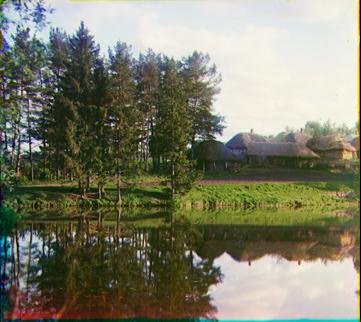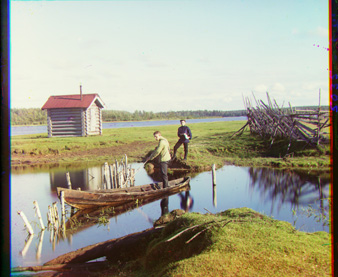1) Split the image in 3.For Step 1) we tried just splitting the image row indices in equal thirds, but this often resulted in one channel having a bit of the next/previous one, due to the asymmetry between the top and bottom white bars caused by the scanning process. To avoid this, we use an edge detection algorithm ('Sobel') and crop based on the innermost first or second maxima for the top and bottom halves of the image. This works because the edges caused by picture limits are around the same position in the 3 frames, so an edge should be detected in the majority of elements of the column of the image and hence have a bigger average value than other columns.
2a) JPEG images: Register using a single grid search.
2b) TIFF images: Register using grid search and scale pyramid.
3) Concatenate channels into one single picture.
BW1) Perform (Photoshop alike) auto levels.
BW2) Perform (Photoshop alike) auto color.
BW3) Crop the image.
For Step 2) we just use a [-15,15] window for the JPG images and [-5,5] window along 6 pyramid levels for the high resolution TIFs. Worthy of note is that we don't a circular shift but instead register only the minimum subset of the image (i.e., the image minus a margin defined by the maximum translation possible at each level), thus avoiding spurious values on the pixels which might interfere with the cost function.
In Step 3), we recalculate the minimum margin possible since the actual translation is possibly smaller than the upper bound used on the previous step. We do this step in order to preserve information that is present in all the channels to be cropped by a too aggressive algorithm (even though this one would produce less artifacts around the edges).
Bells and whistles were applied using the following rationales: Auto levels is just a basic histogram stretching (cf. [1]) but applied on HSV space only to the saturation distribution. We do this to preserve color information (Hue) and because RGB histogram stretching performed too aggressively (see next section). Auto color (code taken from [2]) is done by transforming the image to the NTSC space (where we have access to the luminance and chrominance components of the image) and applying another histogram transformation. Both these processes try to mimic what their respective features in commercial software such as Adobe Photoshop does. Finally, the auto-cropping by detecting the portion of the edges of the image which is dominated by a single color (red, yellow, blue, green). We do this by checking the evolution of the average saturation (in HSV space), both on cols for left and right boundaries and rows for top and bottom borders, selecting the indices where the saturation drops to normal levels as the place to crop.
Back to topBesides the methods described in the previous section, we also tried using a median filter to remove the speckles in the image, performing histogram equalization [1] separately on the R,G,B channels or using the Gray World assumption to adjust the levels of of the R,G,B channels.
For the median filter, no noticeable change was present in the image, despite it's considerable computational complexity. At first, I thought this was due to the use of a small 3x3 window, but this phenomenon repeated itself on the JPEG images, which have lower resolution. I didn't want to use a larger window since some images (e.g., 01047u) have a lot of detail and this might have been lost.
Both histogram equalization (stretching) and gray world assumption resulted in poor quality images, with grain and greenish artificial coloring.
Back to top | 00163v |
 | 00564v |
 | 00149v |
 | 00351v |
 | 00398v |
 | 01112v |
 | 31421v (CMU???) |
 | 00125v |
 | 00153v |

















